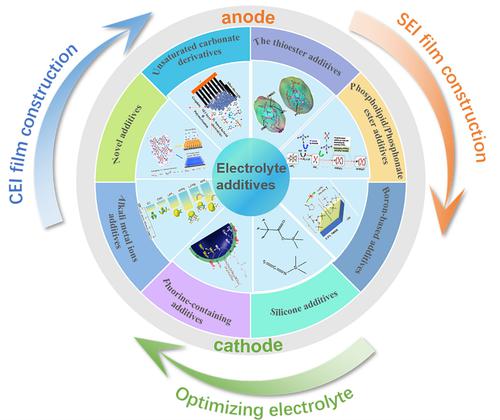当前位置:
X-MOL 学术
›
ChemElectroChem
›
论文详情
Our official English website, www.x-mol.net, welcomes your feedback! (Note: you will need to create a separate account there.)
Recent Progress on Multifunctional Electrolyte Additives for High‐Energy‐Density Li Batteries – A Review
ChemElectroChem ( IF 4 ) Pub Date : 2024-04-15 , DOI: 10.1002/celc.202300702 Yue Lei 1 , Kaifeng Wang 1 , Sen Jiang 1 , Xin Xu 1 , Junzi Zheng 1 , Junying Yin 2 , Yunfang Gao 1
ChemElectroChem ( IF 4 ) Pub Date : 2024-04-15 , DOI: 10.1002/celc.202300702 Yue Lei 1 , Kaifeng Wang 1 , Sen Jiang 1 , Xin Xu 1 , Junzi Zheng 1 , Junying Yin 2 , Yunfang Gao 1
Affiliation

|
The improvement of the safety, specific energy, cycle life and the cost reduction of Li‐ion batteries are hot research topics. Now, in the pursuit of high energy density, the employed high‐energy‐density cathode/anode materials and the increased operation voltage challenge the prevalent electrolyte formula, like the existing ester and ether electrolytes cannot withstand the high‐voltage operation and high‐capacity anode such as lithium (Li), silicon (Si) and silicon‐graphite (Si−C) composite anode. It is recognized that stable electrolyte‐electrode interfaces can avoid the electrolytes side reactions and protect the electrode materials. Up to now, various additives have been developed to modify the electrode‐electrolyte interfaces, such as famous 4‐fluoroethylene carbonate, vinylene carbonate and lithium nitrate, and the LIBs and lithium metal batteries (LMBs) performances have been improved greatly. However, the lifespan of the higher‐energy‐density batteries with Li/Si/Si−C anode and high‐nickel layer oxides cathode materials cannot meet the request due to the lack of ideal electrolyte formula. In this review, we present a comprehensive and in‐depth overview on the electrolyte additives, especially focused on multifunctional additives, the reaction mechanisms of various additives and fundamental design. Finally, novel insights, promising directions and potential solutions for the multifunctional electrolyte additives are proposed to motivate high‐energy‐density Li battery chemistries.
中文翻译:

高能量密度锂电池多功能电解质添加剂的最新进展——综述
提高锂离子电池的安全性、比能量、循环寿命以及降低成本是研究热点。现在,为了追求高能量密度,所采用的高能量密度正极/负极材料和增加的工作电压对流行的电解质配方提出了挑战,现有的酯类和醚类电解质无法承受高电压工作和高容量负极,例如锂(Li)、硅(Si)和硅石墨(Si−C)复合负极。人们认识到稳定的电解质-电极界面可以避免电解质副反应并保护电极材料。到目前为止,人们已经开发出各种添加剂来修饰电极-电解质界面,例如著名的4-氟碳酸乙烯酯、碳酸亚乙烯酯和硝酸锂,并且LIB和锂金属电池(LMB)的性能得到了很大的提高。然而,由于缺乏理想的电解质配方,采用Li/Si/Si−C负极和高镍层氧化物正极材料的较高能量密度电池的寿命无法满足要求。在这篇综述中,我们对电解液添加剂进行了全面而深入的概述,特别是多功能添加剂、各种添加剂的反应机理和基础设计。最后,提出了多功能电解质添加剂的新见解、有前景的方向和潜在解决方案,以推动高能量密度锂电池化学的发展。
更新日期:2024-04-15
中文翻译:

高能量密度锂电池多功能电解质添加剂的最新进展——综述
提高锂离子电池的安全性、比能量、循环寿命以及降低成本是研究热点。现在,为了追求高能量密度,所采用的高能量密度正极/负极材料和增加的工作电压对流行的电解质配方提出了挑战,现有的酯类和醚类电解质无法承受高电压工作和高容量负极,例如锂(Li)、硅(Si)和硅石墨(Si−C)复合负极。人们认识到稳定的电解质-电极界面可以避免电解质副反应并保护电极材料。到目前为止,人们已经开发出各种添加剂来修饰电极-电解质界面,例如著名的4-氟碳酸乙烯酯、碳酸亚乙烯酯和硝酸锂,并且LIB和锂金属电池(LMB)的性能得到了很大的提高。然而,由于缺乏理想的电解质配方,采用Li/Si/Si−C负极和高镍层氧化物正极材料的较高能量密度电池的寿命无法满足要求。在这篇综述中,我们对电解液添加剂进行了全面而深入的概述,特别是多功能添加剂、各种添加剂的反应机理和基础设计。最后,提出了多功能电解质添加剂的新见解、有前景的方向和潜在解决方案,以推动高能量密度锂电池化学的发展。



























 京公网安备 11010802027423号
京公网安备 11010802027423号